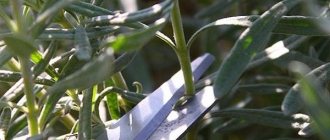Tree peony care in autumn, preparation for winter. Especially for readers of “Popular on Health,” I will consider how to properly end the season for a plant such as a tree peony - care in the fall, preparation for winter, what it involves. How to perform all the necessary manipulations so that this beautiful plant will delight gardeners with its stunning flowers next year?
Features of tree peony
Tree peony is a deciduous shrub whose height varies from 150 to 200 centimeters. Thick, erect shoots are pale brown. Unlike the herbaceous peony, the stems of such a plant do not wither in the autumn, but grow more and more every year, and over time the bush acquires a semi-spherical shape.
The ornamental, openwork leaves are double pinnate. The flowers are located at the ends of the stems and their diameter varies from 12 to 20 centimeters or more. Such flowers are double, semi-double and simple. They can be painted white, purple, yellow, pink, crimson, and are also available in two colors. With age, flowering becomes more abundant. The flowering of such a peony begins 2 weeks earlier than the herbaceous one, and its duration is 14–21 days. Such peonies are resistant to cold.
Planting and caring for tree peonies
- Planting: from mid-August to late September.
- Flowering: April-May.
- Lighting: bright sunlight, light partial shade.
- Soil: fertile loam.
- Watering: twice a month, 6-7 liters of water for each bush, in extreme heat - more frequent watering; from August, watering is gradually stopped.
- Fertilizing: at the beginning of the growing season - with nitrogen fertilizer, during the budding period - with potassium-phosphorus fertilizer, during the flowering period - with a full complex.
- Pruning: annually in spring.
- Reproduction: by dividing the bush, cuttings, layering, grafting.
- Pests: aphids, caterpillars.
- Diseases: gray rot, brown spot, root rot.
Read more about growing tree peonies below.
Tree peony flower , or subshrub, is a species of hybrid plants of the genus Peony of the Peony family. Some scientists argue that this is not even a species, but simply a group of varieties and forms of hybrid origin, of which there are more than five hundred in the world today, and most of them grow in China. The tree peony flower is the product of Chinese breeders, although Japanese flower growers enthusiastically began cultivating this plant as soon as it appeared on the territory of their islands during the Tang Dynasty. Tree peonies were brought to Europe at the end of the 18th century and received absolute recognition from both professional flower growers and flower lovers.
Preparing a tree peony for winter
During the period of preparing the plant for winter, gardeners begin to think about how to preserve peonies in the winter, whether it is necessary to cover the tree peony for the winter and how to do it.
In fact, opinions differ in the floriculture literature; some authors recommend covering peonies in the winter months, while others consider this unnecessary. In fact, peony is not as afraid of frost as early spring thaws, during which the peony buds, uncovered by snow or covered with material, can wake up, and, as a rule, frosts following a thaw can destroy the plant that has begun to grow. Therefore, the conclusion suggests itself that covering the peony for the winter is a completely unnecessary measure.
In order to cover a peony, in October you need to tie up the shoots, mulch the tree trunk with peat (humus), and with the onset of cold weather it is better to cover the plant with a hut of spruce branches, leaves, a thick layer of crushed bark, sawdust or just jute bags so that the tree can overwinter peony went well.
If we are talking about a herbaceous peony, after flowering its stems must be cut to a level of 5-7 cm above the ground and mulched in the same way as described above in the case of a woody peony. If you live in a very cold region, then shelter will be a good idea.
In principle, these are the main aspects that will help you properly care for peonies after flowering and prepare them well for wintering.
How and where to plant a tree peony on the site?
When choosing this shrub for your garden, keep in mind that planting should be done exclusively in late summer or autumn (until mid-September). When planting in spring, there is a very high probability of frost, and this can negatively affect the plant: the buds or even the entire peony will die. A bright, windless place is required. Strong winds can break the branches of a bush. China is the country where the tree peony was first grown. The plant does not require shelter for the winter there. In our climate, this is necessary, so when choosing a place, think in advance where there is more snow on the site. A cone-shaped hole is dug for the peony; crushed stone, brick chips, expanded clay, and gravel are poured onto the bottom. Good humus, 200-300 grams of lime and superphosphate are added to the earth mixture. Planting must be done carefully; under no circumstances should the growth point (root collar) be buried. It is very easy to identify in young plants; it has a larger diameter and resembles a cone. The soil must be well drained. The plant responds well to the addition of ash or bone meal to the soil. It can be mixed with soil before planting. You can dilute it with water and periodically water the peony. This is especially true if the soil is clayey, but you still really want to plant tree peonies.
Rules for pruning tree peony
There are some rules that will help answer the question of whether it is necessary to prune bushes after flowering, and how to do it correctly.
For the procedure to be successful, you need to do the following:
Start pruning for the winter after the first frost, when all the stems of the bush fall to the ground.
The stems of the plant should be cut almost to the root, leaving sprouts above the buds no more than 10 cm high.
The remaining root system must be carefully protected from the cold using humus or dry peat.
When to prune peonies for the winter
The stems and leaves of perennial flowers, left for the winter, are attacked by pathogenic microorganisms, they freeze - the root system suffers from this. The time of pruning depends on the climate of the region. Peonies are prepared for winter in the Moscow region in late October or early November.
Cut off the ground part of the flowers the day after the first frost.
The Volga region, Urals and Siberia are characterized by night frosts at the end of September, so the plant needs to be pruned earlier. The reason for early pruning may be a disease of the bush - then it is necessary to remove the diseased parts so that a few lower undamaged leaves remain. Photosynthesis will allow the flower to recover before winter and form renewal buds.
How to cover a tree peony for the winter
According to experienced gardeners, insulating a tree peony for the winter is not at all difficult. First you need to sprinkle the tree trunk circle with peat, and with the onset of frost, you will only need a few spruce branches, from which you need to build something like a hut around it. To prevent the hut from falling apart, tie the branches with twine.
Alternatively, you can prepare oak leaves in advance and fill the frame built around the bush with them. It additionally needs to be covered from dampness.
The layer of peat with which you will sprinkle the ground around the bushes should be at least 10 cm. For northern regions, you can increase it to 15-20 cm. This warm shelter will not only save the plant, but will also provide the nutrients necessary for growth and development in the spring . Peonies covered in this way will bloom earlier and more abundantly, since peat and humus will become a good growth stimulator for plants.
Do I need to cover it for the winter?
Tree peony has high winter hardiness. A healthy adult bush is able to withstand frosts below -30 ºС and soil freezing to a depth of more than a meter.
However, the success of wintering largely depends on the place of growth. In a quiet place protected from the wind, the plant overwinters well and does not need shelter (Moscow region, middle zone, North-West, Volga region and even in the Urals and Siberia).
It is enough to tie a tree peony with a rope (ribbon, twine) in mid-late October (Moscow region). Do not tie it too tightly, just gather the branches towards the center as if in a bun.
Tying the branches saves them from freezing to the melting snow and icing, as well as from breaking off under the weight of the snow.
- But in open, windy areas in the above regions, it is better to cover tree peonies for the winter, so to speak, “out of harm’s way,” or if your plant has already been seriously frozen in winter.
Propagation of tree peony by seeds
Using seeds, you can not only propagate, but also get your own varieties of tree peonies, which will not be found in any garden. When propagating peony by seeds, you need to have time to collect them correctly and on time. To do this, two weeks after flowering, the seed pods are tied with gauze - this technique will allow you not to lose a single ripened seed. The seeds are collected when the boxes open and the seeds spill out into the gauze.
Tree peony seeds lose their viability quite quickly, so they are sown in the year of collection.
For sowing, prepare an ordinary plastic deep box (for example, for fruit) and a tray suitable in size. Prepare a soil mixture of peat and sand in a ratio of 2:1.
The collected seeds have a very hard shell that must be broken, i.e. perform scarification. For this I use two sheets of fine sandpaper. I put several seeds on one sheet and cover it with a second sheet of sandpaper on top, press it with my palm and roll the seeds, or you can use a file.
Place the seeds in a box with moistened soil to a depth of 1.5 cm, sprinkle on top with a 0.5 cm layer of river sand. To prevent the soil from drying out, the box is inserted into a bag and sealed tightly (I use large garbage bags). The seeds are sown sparsely, with a distance of 10-15 cm from each other, because they will have to spend considerable time in the box, and there should not be crowding. To comply with all recommendations regarding temperature, I choose a hot day for sowing and place the box in the greenhouse at noon. There the seeds are warmed up like in a sauna, and in the evening the temperature slowly drops, which also corresponds to the sowing conditions. In the evening (around 22:00) I take the box from the greenhouse and place it in the refrigerator, where after a while sprouts should appear.
As soon as the plants hatch, I take out the box and bury it in the garden bed (without a tray), build a greenhouse around it, similar to the cuttings, and cover it in the same way for the winter.
Planting process
You will need to dig a cone-shaped hole. The diameter of the hole at the surface, as well as its depth, is approximately 60-70 centimeters. Then make a small layer of drainage from gravel, expanded clay or broken brick, no more than 20 centimeters. When planting several plants, you will need to maintain a distance of 1.5-2 meters.
It is best if the soil has time to settle - so the holes will have to be dug in advance, two to three weeks before planting.
Place fertile soil on top so that it forms a small mound. Now you need to plant and water the tree peony seedling abundantly. After some time, the earth will settle on its own and the roots will straighten out.
If there are buds on a tree peony seedling, they must be removed. After the liquid is completely absorbed, fill the hole. There is no need to trample down the soil.
Propagation of tree peony by cuttings
How to propagate tree peonies from cuttings? We will describe this procedure step by step. Guided by our instructions, even beginners can cope with it. The best time to take cuttings from semi-lignified shoots with well-formed buds is mid-June.
Armed with a sharp knife, cut the cuttings, making oblique cuts directly under the bud.
All leaf blades must be shortened, leaving only 1/3 of their previous length.
After treating the sections with a root formation stimulator, the cuttings are planted at an angle of forty-five degrees in a seedling box filled with a mixture of peat and washed river sand, taken in equal proportions. The buds should be completely buried in the soil and make sure that the cuttings do not touch each other.
To prevent moisture evaporation, the surface of the substrate in the box is covered with a one and a half centimeter layer of sifted sand.
Covering the boxes with plastic film or glass, throughout the entire period of rooting the planting material, they take care of a constant level of soil moisture, not forgetting the need to regularly ventilate improvised greenhouses.
In September or early October, the rooted cuttings are quite ready to be transplanted into individual pots. The best place to keep them until spring and transplant them to a permanent place is a greenhouse.
The disadvantages of this method of propagating tree peonies are the high complexity and labor-intensive process of rooting cuttings and the extremely slow development of young plants (they bloom only in the fifth year of life).
Recommendations
Preparing a tree peony for winter is not very difficult. But beginners and even experienced gardeners sometimes make mistakes when caring for crops, which can cause the plants to suffer or die. To avoid this, it is recommended to consider some practical tips:
- There is never any need to rush into pruning. For example, if you do it in September or early October, the leaves will not have time to release nutrients to the roots. This can lead to weakening of the plant and delayed development.
- If the peony stems are irregularly shaped or there are too few of them, it means that the crop is receiving too few nutrients. Therefore, during care and autumn preparation for winter, shoots are not removed. In this case, pruning is postponed to early spring.
- After an autumn haircut, in preparation for winter, it is advisable to treat all sections with crushed coal powder, a weak solution of potassium permanganate or any fungicide.
- You need to remove the cover in early spring gradually, lifting it from one edge, then from the other. If removed immediately, the plants may suffer from temperature changes and return frosts.
More details Peony Bartzella: photo and description, reviews, care
Reproduction of tree peony by layering
Choose a shoot that is as close to soil level as possible. In May, make a cut on it, but not very deep, and treat it with a stimulant so that roots form. The shoot is tilted to the ground and secured. About 15 cm of soil is poured on top. By autumn, the cuttings will have already taken root, then they are separated from the bush and transplanted to a new place.
You can get a new bush by rooting air layering. To do this, make an incision in the same way, treat it with a stimulant, but then wrap it in moss and film. In August the roots should appear; this method, unfortunately, does not provide a 100% guarantee of success.
How to trim
Pruning peonies for the winter begins with preparing the tool: garden pruners need to be sharpened and treated with an alcohol-containing substance for disinfection.
Gardeners take powdered wood ash/potassium permanganate solution to treat cuttings, humus or peat for mulching.
The order of work differs according to the species of representatives of the Peony family.
Tree peony pruning
Caring for tree peonies in the fall involves removing the stems of an adult bush:
- Three buds on top . The flower buds left below will be filled with strength, and next season the bush will be covered with large flowers.
- Once every 10–15 years, to rejuvenate the bush, cut off all the stems to the border of the second bud from the ground.
- At 0.7–0.9 m . This is formative pruning. It is needed when the plant loses its aesthetic appearance: the branches become spreading, too long, the flowering process becomes sluggish, and the flowers become small.
Every gardener should know that the more you prune a peony bush in the fall, the fewer flowers it will produce next summer. Proper care keeps the culture alive for up to 60–80 years. Rules:
- sections are treated with a disinfectant;
- the plant is watered abundantly, the space around it is mulched with humus (peat) to retain moisture and protect the roots from frost;
- in regions with harsh climates, shelter for the winter is needed.
grassy
Pruning of herbaceous peony is carried out with pruning shears, keeping the blades parallel to the ground. The cut is made at ground level. Afterwards, the stems are treated with ash or a manganese solution. Abundant watering will reduce plant stress after pruning the vegetative organs. The remains of the stems are removed, and the area around the bush is covered with a layer of peat (humus) mulch so that excess moisture or frost does not penetrate to the roots through the cuts. Mulching with organic fertilizers feeds the plant.
Tree peony grafting
The best time to graft a tree peony is the end of August. The rootstock is root segments of herbaceous or tree-like peonies 10-15 cm long; The thickness of the root should correspond to the thickness of the cutting. The roots are dug up 2-3 weeks in advance and kept in a cool place. Scion - only shoots of the current year, preferably with two eyes. Grafting with a wedge-shaped cut. Make a wedge-shaped cut on the rootstock. Cut the bottom of the scion into a wedge shape. The surfaces of the scion and rootstock must be completely smooth so that the cambial layers coincide. Insert the scion into the rootstock, tie tightly with insulating tape (sticky side out) and coat with garden varnish.
Grafted plants can be planted in the ground immediately after grafting. But it is better to first plant the grafted material for 3-4 weeks in a greenhouse protected from direct sunlight, leaving the graft above the soil level, and water it regularly. Another option is to keep the grafted material in the basement for 3-4 weeks - in a horizontal position, in 2-3 layers, layered with wet sawdust.
Lateral grafting. Cut the scion diagonally at a slight angle. Cut the root at the same angle. Tie the combined scion and rootstock tightly and coat with garden varnish.
The best varieties of tree peonies for the Moscow region
In the Moscow region you can plant a wide variety of peonies. They take root easily, bloom profusely, and tolerate winters well. Due to their unpretentiousness, frost-resistant shrubs are used in landscape design.
The following varieties of tree peonies are recognized as the best for the Moscow region:
- “August Dessert” with soft pink double or semi-double buds;
- "Vesuvius" - purple-red flowers remain open for up to 14–20 days;
- "Maria" - delicate terry buds with a pink core;
- "Hoffmann" is a frost-resistant variety with large double pink flowers; one of the first to bloom;
- “Blue Lagoon” is a tall peony with bluish-pink buds;
- “Spring Waltz” is an early flowering, spreading shrub with a short flowering period (5–7 days);
- "Kuindzhi" is one of the best varieties with spreading yellow inflorescences.
Frost-resistant tree peonies are recognized as the most unpretentious in care, cultivation and propagation for the Moscow region:
- “Blue Sapphire” - grows quickly, blooms for a long time, withstands frosts down to -40 degrees;
- “Scarlet Sails” - one of the first to bloom (in mid-May), produces up to 70 buds per season;
- "Jade Princess" is a low-growing, spreading shrub with lush white blooms.
Breeders have bred more than 200 tree-like varieties of peonies, any of which, following the recommendations, can be grown independently
Diseases and pests of tree peony
The tree peony is more resistant to disease than its herbaceous counterpart. The only significant threat may be gray rot, the development of which is facilitated by excess moisture. In this case, the affected leaves must be immediately removed and burned, and the plant itself must be treated with a solution of copper sulfate or potassium permanganate.
If you want to have a spectacular and unusual perennial plant on your site, then let it be a tree peony. Preparing for winter and caring for it will not take much time, and its unusual appearance and bright flowers will delight the eye and surprise guests. It can be planted either as single bushes or in group plantings, for example, with ordinary herbaceous peonies. And although shrub seedlings are quite expensive, its perennial flowering more than compensates for all costs.
Planting tree peonies
Let's look at how to plant and care for a peony in open ground. Planting is carried out in August-September. You need to choose a sunny area for planting. There should be no tall trees nearby so that the shadow does not fall on the peonies. You can plant peony bushes as a hedge.
Loamy soil is best suited; if the site has sandy soil, you need to add peat, clay or humus to it. Clay soil is fertilized with organic fertilizers and sand. The place needs to be taken care of carefully, since peony can be grown in one place for 80-100 years.
Dig a conical hole about 70 cm deep and the same diameter. A 30-centimeter layer of sand and broken bricks is poured onto the bottom. If the soil is acidic, add bone meal or lime, then fill the soil, place the plant and pour in a lot of water so that the tree peony roots straighten out in it. As soon as the water is absorbed, fill the hole. Tree peony bushes should be planted at a distance of two meters from each other.
You may be interested in: Caring for peonies in the fall, preparing for winter
Growing peonies from seeds
You can plant a tree peony with seeds, then the plant can bloom within 5 years after planting. The main thing is to stratify. The procedure is carried out in two stages: warm, then cold. But even such manipulations do not guarantee that the plant will grow, since peonies need careful care.
Feeding peonies in the fall: timing and fertilizers
Feeding peonies is usually done a couple of weeks after they have flowered and the flower stalks have been trimmed. In other words, the approximate dates for the autumn application of fertilizers for peonies are August-early September, and the specific dates depend on the climatic conditions of your region.
Interesting! Many gardeners combine fertilizing with autumn pruning of stems.
As for what fertilizers peonies require during this period, it is, of course, phosphorus and potassium, for example, a mixture of the same superphosphate and potassium sulfate or bone meal and wood ash . Alternatively, you can use any fertilizer labeled “autumn.”
Important! In the fall, under no circumstances should nitrogen fertilizers , which stimulate the growth of green mass.
There are the following ways to feed peonies and other plants:
- in dry form;
- in liquid form.
If the autumn turns out to be dry, then it is better to dilute phosphorus-potassium fertilizers in water according to the instructions and apply directly under the roots. A liter of this solution is enough for each bush.
In rainy weather, it is better to use granular fertilizers, which gradually enter the root system of the plant. Typically, dry fertilizers are scattered in the tree trunk of the plant, lightly embedding them into the soil.
By the way! The site has a separate article on how to properly feed peonies in spring, summer and autumn for abundant flowering .











